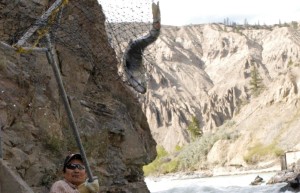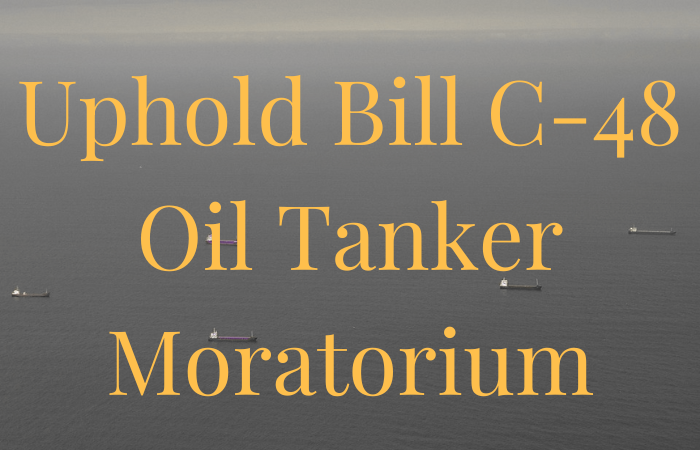Commemoration of war
May 3, 2014Joint response to approval of Northern Gateway pipeline
June 20, 2014“The Duty to Consult, Aboriginal Communities, and the Canadian Natural Resource Sector”: A Flawed Analysis by Dwight Newman
Paul Joffe
May 27, 2014
For the references in this article download the PDF version.
In May 2014, the Macdonald-Laurier Institute (MLI) published a paper by Professor Dwight Newman The Rule and Role of Law: The Duty to Consult, Aboriginal Communities, and the Canadian Natural Resource Sector.

Xeni Gwet’in member Edmund Lulua salmon fishing at Farwell Canyon. Credit: UBCIC
MLI describes itself as “independent and non-partisan … prodding governments, opinion leaders and the general public to accept nothing but the very best public policy solutions for the challenges Canada faces.” Yet to a large degree, this paper does not exhibit these attributes. The analysis in Professor Newman’s paper is seriously flawed. The legal foundation and framework relating to Indigenous peoples’ rights and titles are inadequately described and taken into account. As a result, arguments are skewed in favour of non-Indigenous governments and resource development proponents.
Key issues and concerns are illustrated below.
1. Indigenous peoples’ rights not described as inherent. In addressing the Crown’s duty to consult Indigenous peoples on the rights in s. 35 of the Constitution Act, 1982, Professor Newman fails to indicate that Aboriginal rights are inherent or pre-existing as affirmed by Canada’s highest court. The United Nations Declaration on the Rights of Indigenous Peoples [“UNDRIP”] also affirms that Indigenous peoples’ rights are inherent.
2. Indigenous peoples’ “title” to lands, territories and resources not addressed. “Aboriginal rights” can include “title” and the paper should have explicitly considered this important aspect. The real and potential impacts of resource development on Aboriginal title may differ significantly from those on specific rights.
3. Indigenous peoples’ rights in s. 35 continue to evolve. The Supreme Court ruled that “the constitutionalization of common law aboriginal rights by s. 35(1) does not mean that those rights exhaust the content of s. 35(1).” The paper fails to mention this. Instead, Professor Newman recommends: “courts should be very cautious about continuing to expand the duty to consult doctrine into new contexts. Courts need to leave flexibility for governments to design appropriate procedures for complex scenarios … Vital transportation infrastructure, such as new pipelines, depends upon all taking reasonable approaches.” (p. 2)
4. “Progressive” interpretation of Canada’s Constitution not encouraged. The paper fails to consider that the Constitution is “a living tree which, by way of progressive interpretation, accommodates and addresses the realities of modern life”. UNDRIP is such a reality. It represents “an authoritative common understanding, at the global level, of the minimum content of the rights of indigenous peoples, upon a foundation of various sources of international human rights law.” UNDRIP calls for “a large and liberal, or progressive, interpretation” of the Constitution so as to ensure its “continued relevance and, indeed, legitimacy”.
5. Indigenous peoples’ rights as human rights should have been considered. Indigenous peoples’ collective rights are human rights and are addressed as such in international and regional human rights systems. In particular, property rights to lands and resources are recognized as human rights in international law. Thus, in addressing Indigenous peoples’ rights, it is important to take a human rights-based approach. Professor Newman makes no mention whatsoever of “human rights”.
6. UNDRIP is an important source for interpreting Indigenous rights. UNDRIP is a consensus, universal human rights instrument. No country in the world formally opposes it. Declarations and other international instruments, as well as customary international law, are “relevant and persuasive” sources for interpreting human rights and related State obligations in Canada. Canadian courts are using UNDRIP for such purposes. Yet Professor Newman’s paper discourages courts from using UNDRIP to interpret the Crown’s duty to consult, claiming that “extending [the duty’s] technical legal applications can create problems.” (p. 20)
7. UNDRIP has essential role in the context of resource development. The “Guiding Principles on Business and Human Rights”, adopted by the UN Human Rights Council, affirm that business enterprises have a responsibility to respect “internationally recognized human rights”. The commentary in the Guiding Principles emphasizes that consideration be given to UN instruments that have elaborated on the rights of Indigenous peoples. This clearly includes UNDRIP, especially since “overwhelming support by the UN General Assembly leads to an expectation of maximum compliance”. The UN Global Compact has produced an in-depth “Business Reference Guide” in regard to UNDRIP. Professor Newman’s paper is regressive in not integrating the international human rights of Indigenous peoples and UNDRIP.
8. Principles of good governance are relevant. In regard to the Canadian Charter of Rights and Freedoms, the Supreme Court ruled: “Compliance with Charter standards is a foundational principle of good governance.” The same rule must apply to the human rights of Indigenous peoples in s. 35 of the Constitution Act, 1982. In the 2011 Updated Guidelines for Federal Officials to Fulfill the Duty to Consult, there are numerous references to good governance. Yet Professor Newman does not consider principles of good governance, which are among the core principles in UNDRIP.
9. Right to give or withhold “consent” not synonymous with “veto”. The term “veto” may imply an absolute right to block a proposed development regardless of the facts and law in any given case. In contrast, Indigenous consent in international and Canadian law is neither arbitrary nor absolute, but responds to the rights at stake and the potential for harm. The Supreme Court of Canada ruled that – at the high end of the consultation spectrum – the Crown’s duty to consult would require the “‘full consent of [the] aboriginal nation …’ on very serious issues”. The Special Rapporteur on the rights of indigenous peoples, James Anaya, has concluded: “Indigenous peoples’ free, prior and informed consent is required, as a general rule, when extractive activities are carried out within indigenous territories.” Anaya adds: “The general rule identified here derives from the character of free, prior and informed consent as a safeguard for the internationally recognized rights of indigenous peoples that are typically affected by extractive activities that occur within their territories.” Professor Newman never addressed “consent” in regard to the duty to consult or any other context.
10. “Veto” portrayed inaccurately. At p. 9, Newman indicates: “The courts have consistently reiterated that the duty to consult is not a legal veto power”. In support of this statement, Newman cites Haida Nation, para. 48. However, the Supreme Court referred to “veto” solely in the context of asserted Aboriginal rights but yet unproven. Where a strong prima facie case exists, the Supreme Court focused on finding interim solutions “pending final resolution”. The issue in such situations is not “veto”.
11. Indigenous peoples’ status and rights as self-determining “peoples” not considered. The right of Indigenous peoples to self-determination is a prerequisite to the enjoyment of all other human rights. It is “a foundational right, without which indigenous peoples’ human rights, both collective and individual, cannot be fully enjoyed.” In regard to the two international human rights Covenants, the right of self-determination – including the right to natural resources – has been applied to Indigenous peoples by UN human rights bodies. The right of self-determination includes “consent”. None of these considerations are included in Professor Newman’s analysis.
12. Underlying constitutional principles are relevant in interpreting Aboriginal and treaty rights. Such principles, often unwritten, are “invested with a powerful normative force, and are binding upon both courts and governments”. These principles “dictate major elements of the architecture of the Constitution itself and are as such its lifeblood.” Such principles include: federalism, democracy, the rule of law, and respect for minority rights. A further underlying principle is “respect for human rights and freedoms”. “These defining principles function in symbiosis. No single principle can be defined in isolation from the others, nor does any one principle trump or exclude the operation of any other.” “Protection of existing aboriginal and treaty rights” can be “looked at in their own right or as part of the larger concern with minorities”.
13. Federalism principle requires more than consultation. Indigenous peoples, as self-determining peoples, are an essential part of the principle of federalism. In this context, Indigenous peoples must be “endowed with the institutions and rights necessary to maintain and promote their identities against the assimilative pressures of the majority.” The three elements in Canada’s Constitution are federal, provincial and Aboriginal. The Supreme Court has emphasized: “Cooperation is the animating force” in the federalism principle and “nothing less”. In implementing the provisions in UNDRIP, States are required as a minimum standard to take measures “in consultation and cooperation” with Indigenous peoples.
14. Rule of law inadequately considered. Although the title of Professor Newman’s paper highlights the rule of law, the text only includes a single explicit reference. In international law, “human rights, the rule of law and democracy are interlinked and mutually reinforcing.” Such interrelationships are highly relevant to Aboriginal and treaty rights. For example, democracy is “fundamentally connected to substantive goals, most importantly, the promotion of self-government”.
Indigenous peoples’ rights are not a barrier to economic development. The rights of Indigenous peoples as protected in domestic and international law provide a principled, unbiased framework to ensure that development which does take place will be carried out sustainably and will benefit Indigenous peoples, rather than compounding the injustices they have experienced.




